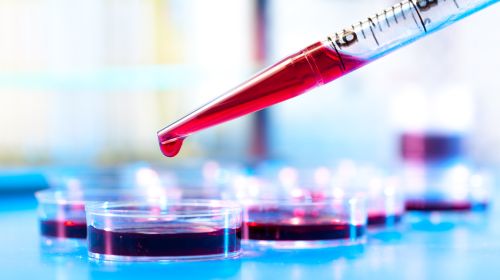Although testosterone is considered the most important male sex hormone, it also plays an important role in the woman's body. If the testosterone level is too high or too low, there can be numerous diseases behind it – all about possible causes, tests and natural antidotes.
- If the testosterone in the blood is too high or too low, there can be a serious illness behind it.
- © iStock.com/jarun011
The central male sex hormone is not only important for male potency, but also for muscle growth, bone density and fat metabolism in both sexes. In men it is mainly produced in the testicles, but also in the adrenal cortex, in women the adrenal cortex and the ovaries are also responsible. Changes in testosterone levels can be a normal sign of aging, but they can also indicate a serious illness such as cirrhosis of the liver or a tumor.
Overview of article content:
When is the testosterone level measured?
The doctor will determine testosterone levels whenever symptoms of a disruption in male sex hormone production appear. This includes:
Disorders of puberty development
Disorders of the female menstrual cycle
Signs of masculinization in women (e.g. hirsutism)
Erectile dysfunction
infertility
Suspected hormonally active tumors (e.g. testicular or ovarian tumors)
What is the normal testosterone level?
The level of testosterone in the blood is subject to strong fluctuations in the time of day, with the highest values being in the morning. For this reason, the blood collection required to determine the testosterone value is carried out in the morning between 8 and 10 a.m. In order to compensate for the natural fluctuation range, three blood samples are usually taken at intervals of 20 to 30 minutes and combined. In women of childbearing age, samples are taken between the 3rd and 7th day of the cycle.
Since most of the testosterone binds to proteins for transport, the so-called "total testosterone" is measured in most cases. With certain diseases of the liver, kidney or thyroid, the concentration of the proteins is too low, which leads to measurement errors in the testosterone determination. In this case, the doctor measures the unbound, so-called "free testosterone". The following standard values apply:
| Total testosterone | free testosterone | |
| Men | 2.6-10 ng / ml 9-34.7 nmol / l | 85-280 pg / ml 295-971 pmol / l |
| Women | 0.1-0.86 ng / ml 0.35-3 nmol / l | 3-13 pg / ml 10.4-45 pmol / l |
Testosterone too low or too high? Possible reasons
For increased testosterone levels The following causes are possible in the blood:
For men:
For women:
For decreased testosterone levels (Testosterone deficiency) in the blood there are the following causes:
At Men:
At Women:
Diseases of the ovaries
Adrenal insufficiency
Taking ovulation inhibitors, estrogens or antiandrogens
Cirrhosis, malnutrition, or drug addiction can also be the cause of low testosterone levels in both sexes.
Affect testosterone levels with home remedies
If there is a serious illness behind the changed testosterone levels, the doctor will initiate suitable therapy to combat the causal problem. In this case, the increased or decreased testosterone level is just the symptom of another disease. In some cases, however, the testosterone level derails without any underlying diseases – a falling value is a normal sign of aging in men, in women the testosterone value is often increased after stopping the pill and leads to acne, hair loss and cycle disorders. A change in lifestyle can often contribute to regulating the hormonal balance.
This is how men increase their testosterone levels
Intensive physical training leads to an immediate increase in the level of testosterone in the blood. The best results are achieved by moderate strength training combined with endurance sports. Ideally, this also reduces the abdominal circumference, which also has a positive influence on the testosterone value, since the abdominal fat converts the hormone testosterone into the female hormone estradiol. The less of it there is, the less testosterone is converted.
Diet can also have a positive impact on testosterone levels. In addition to the generally recommended reduction in obesity, avoiding certain foods that lower testosterone levels can also be helpful. The phytoestrogens it contains work in a similar way to the female sex hormone estrogen. These foods include:
Those who avoid these foods and also ensure a low level of stress and adequate sleep can make a natural contribution to increasing testosterol in the blood.
This is how women lower their testosterone levels
If women stop using hormonal contraceptives, the hormonal balance is often confused, and testosterone gains the upper hand. Normally, the hormones level off within half a year, this process can be supported with natural means.
Nutrition makes an important contribution. Soy and dairy products contain so-called phytoestrogens, which have a positive effect on lowering testosterone levels. Sesame and linseed contain Lingnane, which can stimulate the production of estrogen and reduce free testosterone. If you keep your blood sugar level under control, you also make a positive contribution to lowering the testosterone level: insulin, which triggers an androgen-producing effect, is required to break down sugar. The more insulin is made, the more male hormones are produced. The absence of white flour products, refined sugar, fast food and sweetened drinks can have a positive effect here.


